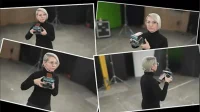NVIDIA has greatly improved the NeRF technique for creating 3D objects from 2D photographs almost instantly.
A new technology called Neural Radiance Field (NeRF) uses artificial intelligence learning algorithms to create 3D objects from 2D photographs. NeRF has the ability to fill in the gaps, so to speak, by interpolating what 2D photos can’t capture. This is a very interesting achievement that could lead to significant advances in areas as diverse as video games or autonomous driving. Now NVIDIA has developed a new technology, NeRF, which the company says is the fastest to date, taking just a few seconds to learn how to create a 3D scene.
NVIDIA significantly improves NeRF technique
It takes only a few seconds to study the Instant NeRF model using dozens of freeze frames and camera angles. After that, the system is able to generate a 3D scene in “several tens of milliseconds.”As with any other NeRF method, you need to take pictures in different positions. And for photos with multiple scenes, it’s better to have images without unnecessary movement, otherwise the result will be blurry.
almost instantly create 3D objects from 2D photos
NVIDIA explains that the first NeRF models are producing results fairly quickly. It only takes them a few minutes to create a 3D scene, even if the object is hidden in some images by a column or furniture. The training takes several hours. In the NVIDIA version, this step only lasts a few seconds, as it uses a technology developed by the company called “Multi-Resolution Hash Grid Encoding”, which is optimized for optimal performance on this brand’s GPUs. The system can even run on a single GPU, although the fastest results are achieved on boards with Tensor Cores, providing performance boosts for all AI tasks.
The company believes that Instant NeRF can be used to train robots and help autonomous driving systems understand the sizes and shapes of objects in the real world. NVIDIA also sees opportunities for technologies in entertainment and architecture. This can be used to create 3D models of real environments that creators can modify during the planning process.


